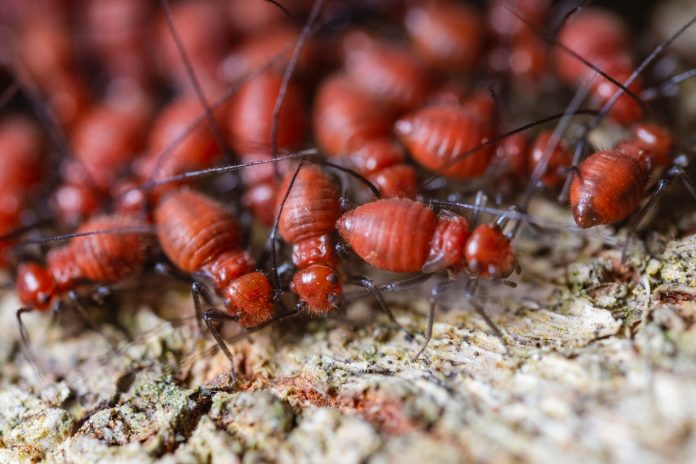
Termites are easy to recognize once they fall out of holes they created in woodwork, wooden window frames or any other wooden structure on your property. They are pale, six-legged soft-bodied, wingless insects.
But you need to identify them before your home gets into that state.
Termites reproduce rapidly and can quickly make homes uninhabitable, so always be on the lookout for termites on your property.
Winged Breeders
 Winged breeders or alates are often seen far before workers, soldiers, or other members of a termite colony.
Winged breeders or alates are often seen far before workers, soldiers, or other members of a termite colony.
Depending on the species they may fly out as a swarm anytime from early spring to the Indian summer of fall. These are newly hatched queens and drones off for their one and only mating flight.
Some workers and soldiers from their parent colony will follow the new queen as she finds a new place to establish her colony.
Winged workers look a lot like flying ants. But they lack the wasp waist of ants, the long L-shaped antennae, and have a different wing shape.
Winged termites have four wings that are all of the same size while flying ants have one pair of wings noticeably larger than the other.
Mud Tubes
 Since termites live hidden lives, seeing the actual termites may not happen until it is too late. But they do leave signs of their travels. One of the most recognizable is a mud tube.
Since termites live hidden lives, seeing the actual termites may not happen until it is too late. But they do leave signs of their travels. One of the most recognizable is a mud tube.
Termites have softer bodies than many other types of insects and can dry out when exposed to light for long periods of time. Subterranean termites, especially, need to keep in moist soil in order to stay alive.
When termites send out scouts that look for new food sources, the scouts need protection. When the termite returns to the colony and brings more workers back to harvest food, they also need protection.
So termites make mud tubes?
These tubes can travel up walls, across concrete (especially if the concrete is cracked), along with basements, and on untreated wooden fencing. They look as their name suggests, thin dirt lines etched on the surface.
Dry mud tubes that crumble when open and do not reveal any workers mean that tube has not been used in a while. That does not mean that termites have left your home. They just moved somewhere else to feed.
Fraxss
Entomologists call insect feces “frass.” Since termites live in colonies, they produce a lot of frass. In order to keep the colony healthy, workers push frass out of holes leading to the colony.
The presence of frass can help you and your exterminator locate where a colony is without having to rip out any expensive woodwork.
You can also tap wooden posts, bookcases, fencing or stairs to see if any frass falls out. Frass can resemble sawdust or tiny brown pellets.
Different types of termites produce different shaped frass. Your exterminator will have to examine the frass in order to identify the termites in your property.
References:
University of California, Agriculture and Natural Resources. “Termites Management Guidelines.” http://www.ipm.ucdavis.edu/PMG/PESTNOTES/pn7415.html
University of Kentucky. “Termite Control: Answers for Homeowners.” http://www.ca.uky.edu/entomology/entfacts/ef604.asp

